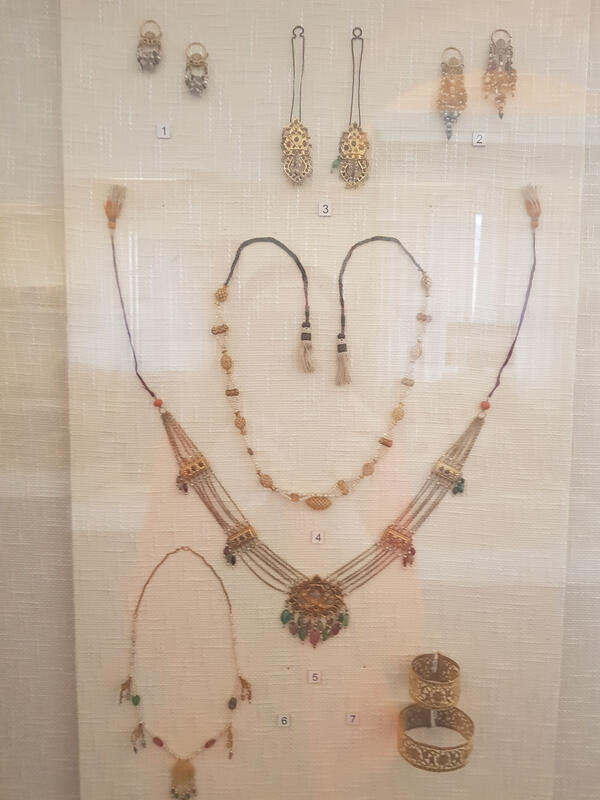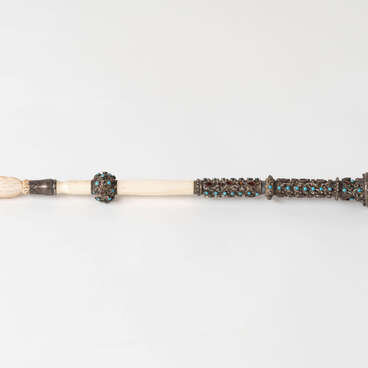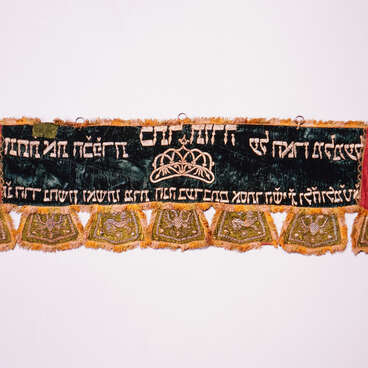Jewelry was essential for the traditional costume of Bukharian Jewish women, as it was in the cultures of all the Central Asian peoples. Girls had their ears pierced at an early age and wore simple earrings. Children wore beads around their necks and bracelets of colored beads on their wrists. As girls grew older and reached adulthood, their jewelry became more expensive and varied.
A set of festive jewelry for married women under 40-45 years of age included a headdress, temple pendants, several types of neck and chest ornaments, earrings, bracelets, and rings. The quantity of jewelry items and their value depended on the family’s financial situation. Bukharian Jews could order jewelry from Tajik and Uzbek jewelers, but they more often turned to Jewish artisans, who were highly valued for their craft.
In type and form, most Jewish jewelry was similar to that of Tajiks and Uzbeks. The main difference was in material: Uzbek and Tajik jewelry was made of silver with inlays of colored glass, and that of the Bukhara Jews — of gold or silver with gilding, with precious stones and pearls. The special attitude toward gold goes back to the common religious tradition of many Jewish groups preserved since ancient times.
The biblical texts describe in detail the luxurious clothing, jewelry, and household items of the nobles. They were made of gold and semi-precious stones, as silver at that time was not yet considered a valuable metal. Pearls and colored gemstones such as spinel red gems, tourmalines, rubies and diamonds were believed to have a sacred significance. Jewelry was not supposed to be cheap, as it was worn by the woman all her life and was inherited by her daughters, daughters-in-law and granddaughters.
One of the favorite ornaments of Bulgarian Jewish women is a kalmola sofigi made of strings of pearls and gold filigree beads, like the item from the collection of the Russian Museum of Ethnography. In the center of the necklace is a gold openwork cylindrical pendant with three pyramids of granules on the lower edge and with two loops on the upper edge. The necklace consists of two strands of pearls, eight gold stamped plates and eight gold filigree balls.
A set of festive jewelry for married women under 40-45 years of age included a headdress, temple pendants, several types of neck and chest ornaments, earrings, bracelets, and rings. The quantity of jewelry items and their value depended on the family’s financial situation. Bukharian Jews could order jewelry from Tajik and Uzbek jewelers, but they more often turned to Jewish artisans, who were highly valued for their craft.
In type and form, most Jewish jewelry was similar to that of Tajiks and Uzbeks. The main difference was in material: Uzbek and Tajik jewelry was made of silver with inlays of colored glass, and that of the Bukhara Jews — of gold or silver with gilding, with precious stones and pearls. The special attitude toward gold goes back to the common religious tradition of many Jewish groups preserved since ancient times.
The biblical texts describe in detail the luxurious clothing, jewelry, and household items of the nobles. They were made of gold and semi-precious stones, as silver at that time was not yet considered a valuable metal. Pearls and colored gemstones such as spinel red gems, tourmalines, rubies and diamonds were believed to have a sacred significance. Jewelry was not supposed to be cheap, as it was worn by the woman all her life and was inherited by her daughters, daughters-in-law and granddaughters.
One of the favorite ornaments of Bulgarian Jewish women is a kalmola sofigi made of strings of pearls and gold filigree beads, like the item from the collection of the Russian Museum of Ethnography. In the center of the necklace is a gold openwork cylindrical pendant with three pyramids of granules on the lower edge and with two loops on the upper edge. The necklace consists of two strands of pearls, eight gold stamped plates and eight gold filigree balls.



